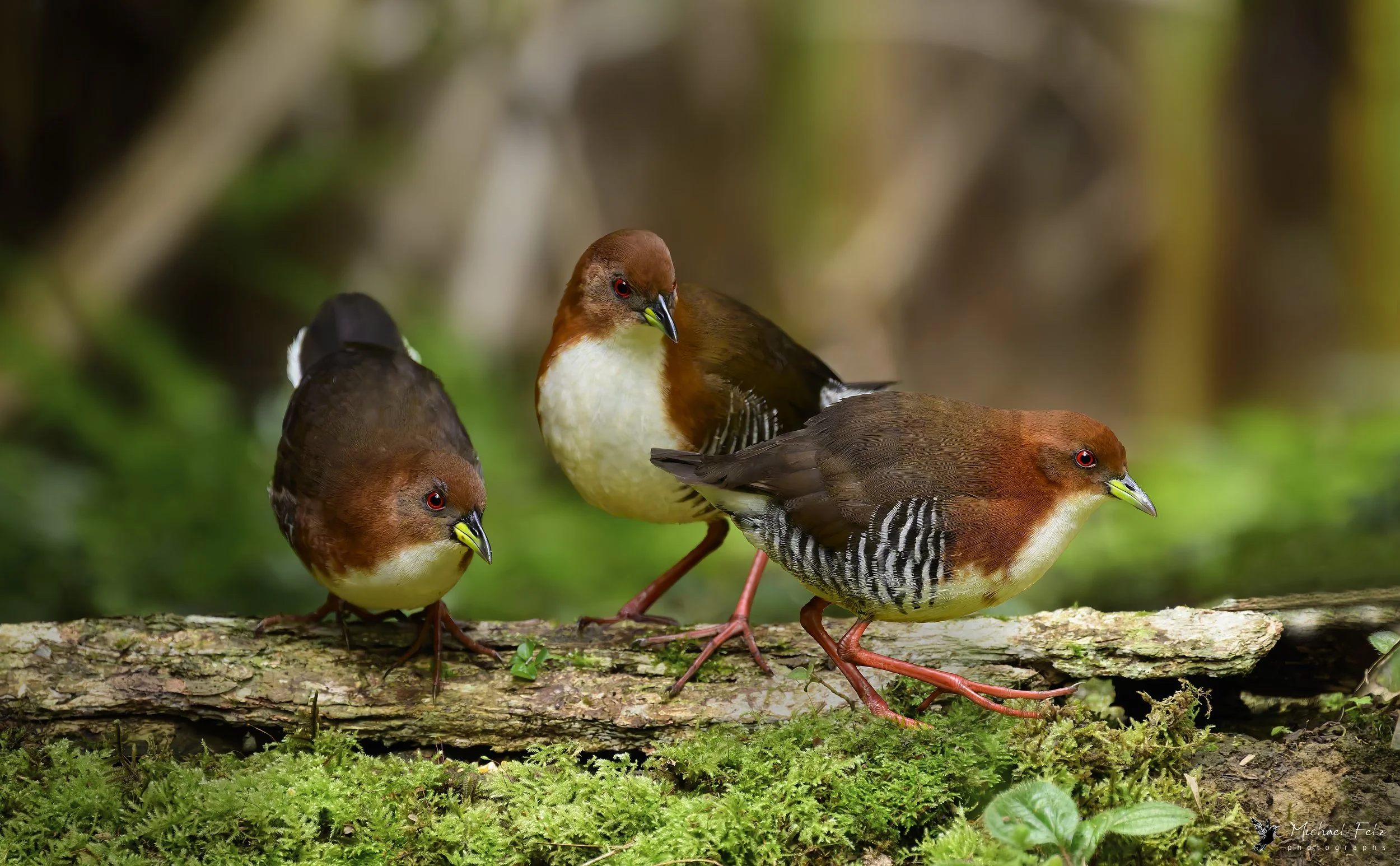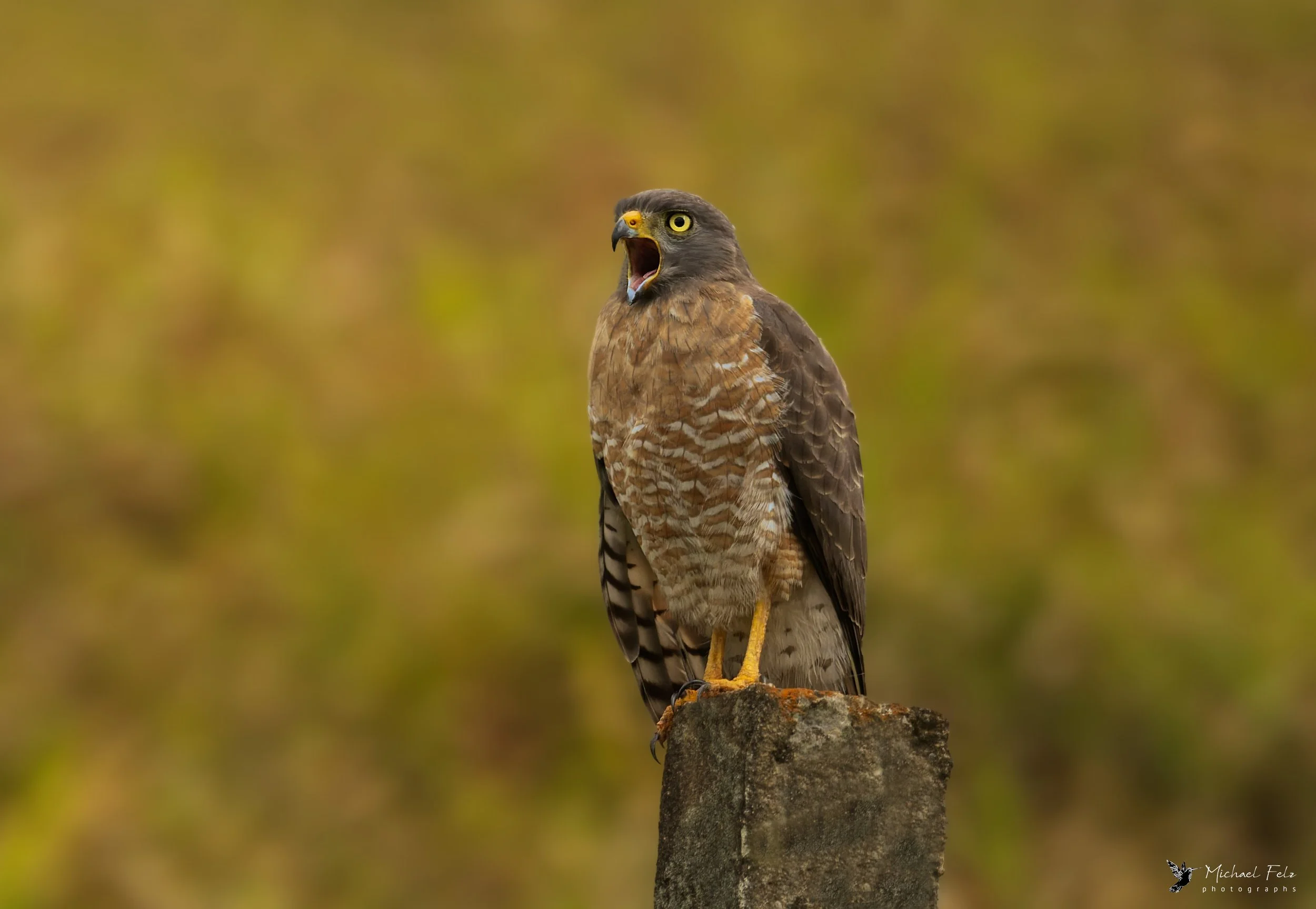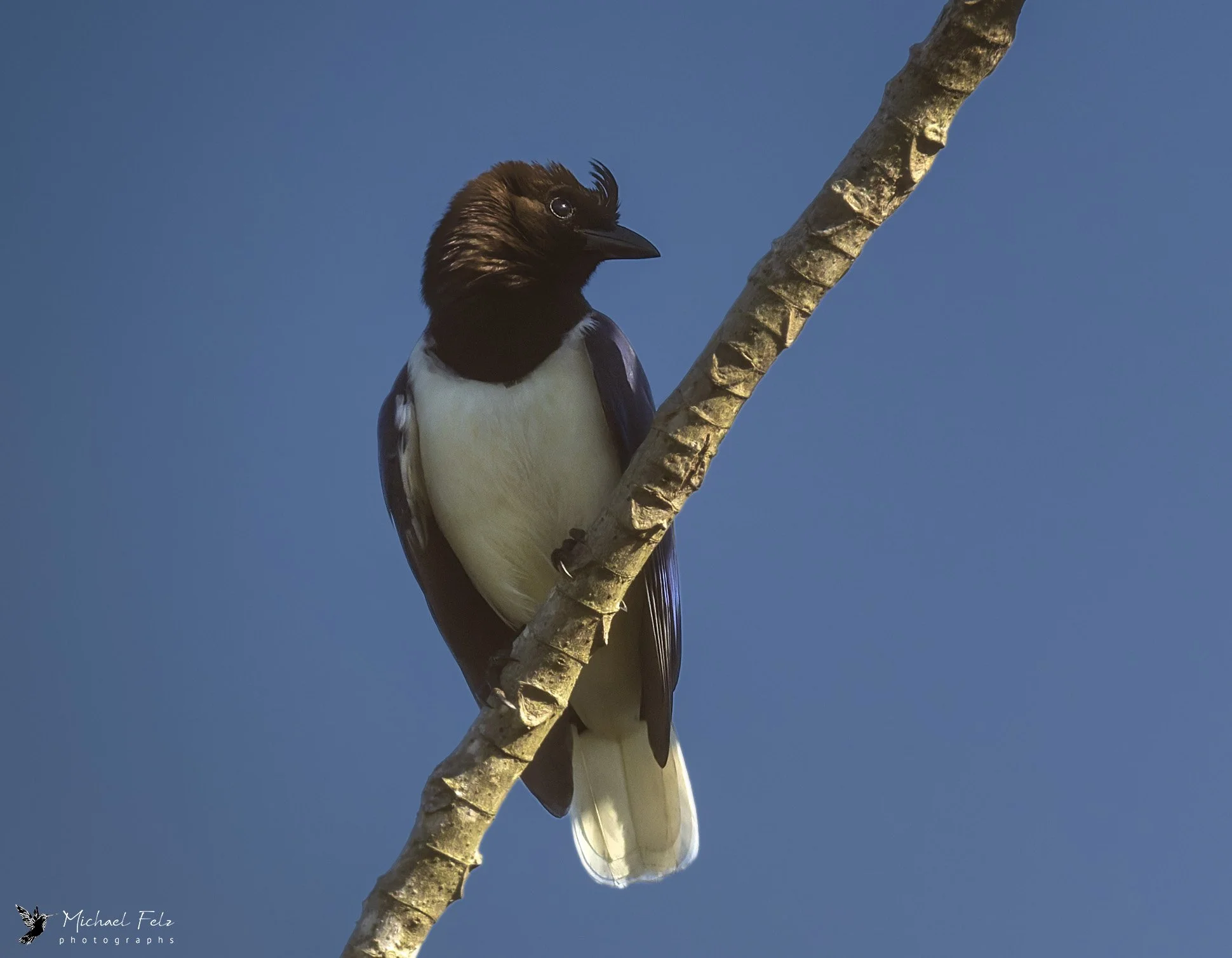
new!
scroll down for more!
The Red-and-white Crake (Rufirallus leucopyrrhus) has some color combinations that it can pull off with style. A marsh bird, this was the first of several new species for me that I photographed at Sitio Macuquinho near Salesopolis, Sao Paulo, Brazil. It has a partially greenish beak, red eyes, white breast, rufous head and neck, chestnut back, coral legs and feet, and distinctive white and black barred underfeathers.
The Blue Dacnis (Dacnis cayana) often frequent treetops looking for insects, though this rainy day they came down to check out a flower pot at Ninho da Cambacica. Here’s a male (bright blue with a black throat) and female (light green with a light blue crown).
We were fortunate to visit a narrow strip along Southeast Brazil’s Atlantic coast, on the edge of the tall forests, where the loud and beautiful Channel-billed Toucans (Ramphastos vitellinus) frequent. We observed them eating the plentiful palm nuts and other fruits, though evidently they’ll eat other birds, small lizards, frogs, etc. These were at Pousada Salve Floresta, a bit south and east of Sao Paulo.
The Sharpbill (Oxyruncus cristatus) has no close relatives so is placed in its own family. As the name implies, it has a cone-shaped sharp bill and is greenish-yellow with white and black spots below. It has a rarely seen reddish-orange crest on top of its head (hence, the “cristatus” part of its scientific name). This one was on the grounds of the Hotel Donati lodge located within Brazil’s first national park, the Parque Nacional do Itatiaia.
This sweet little Bay-breasted Warbling Finch (Castanozoster thoracicus) is endemic to southern Brazil. Its habitat is at elevation (this one was at 2,130m). Its distinctive white eye patch is plainly seen in this photo while less evident is the reddish band around its breast and flanks.
For a bird that loves to perch at the forest’s edge, you’re bound to been seen and named a Roadside Hawk (Rupornis magnirostris). We saw this one on our way to Ninho da Cambacica Villa, a wonderful spot to photograph just north of Ubatuba, Brazil.
After a few wonderful rainy days at Ninho da Cambacica, we hit the road for destinations west of São Paulo. We came across this very handsome male Yellow-fronted Woodpecker (Melanerpes flavifrons) along the way to the coastal town of Ubatuba. Males have a red crown while females have a blue-black crown.
Southeast Brazil is such a nice place for bird photography that even when you stop for lunch you mustn’t forget your camera. Here’s a Plain Parakeet juvenile (Brotogeris tirica) sitting out the rain on a palm leaf just downhill from our picnic table.
Near the top of the list of entertaining birds, the Magpie Tanager (Cissopis leverianus) is one of a kind as the only member of the genus Cissopis, but might be strangely familiar to those in northern and western North America who are similarly entertained by the corvid Black-billed Magpies (Pica hudsonia). This Magpie Tanager was in the forest edge at Trilha dos Tucanos, near Tapiraí, SP Brazil.
I tried for a good long while to photograph this Sapphire-spangled Emerald (Chionomesa lactea) in flight with its pinkish/reddish lower mandible showing - best I could get is this glimpse at the Sitio Macuquinho near Salesópolis, Brazil.
Art or accident? I made a masking error while processing this photo of a Streamer-tailed Tyrant, including a bit of the branch with the bird. I got rid of the background and liked this result.
This male Violet-capped Woodnymph (Thalurania glaucopis) was photographed at Hotel Donati, located in the Parque Nacional do Itatiaia, located between Sao Paulo and Rio de Janeiro, Brazil.
Tanagers are distinguished by their vibrant, sexually dimorphic plumage, their fruit and insect diet, and their living in the forest canopy. The male Brazilian Tanager (Ramphocelus bresilius) is further distinguished by its vivid, rich red plumage. This one and its mate were visiting the Sitio Macuquinho Lodge in southeast Brazil.
I was reading of the diet and foraging habits of the Cinnamon Tanager (Schistochlamys ruficapillus) and came across something to help my own diet and foraging - www.Birdsandbeanscoffee.com. I’m not connected in any way, but it’s organic, fair trade, and and grown in a bird-friendly manner so I’m going to give it a try!
We found this wind-blown Rufous-fronted Thornbird (Phacellodomus rufifrons) near Brazil’s Parque Nacional do Itatiaia. It would have been nice to find its nest. The nests are built as long cylinders, often with thorny branches, and may be up to 6 feet long containing several “chambers”.
The first project off the plane after 48 hours of travel and delays was (trying) to photograph Southern Yellowthroats (Geothlypis velata). Long considered a subspecies of the Masked Yellowthroat, now its own species, the Southern Yellowthroat hops and flits around very quickly close to the ground among grasses, cattails, and weeds. Its perches are seldom clean for photography. A nice challenge to start our trip to southeast Brazil!
The national bird of Brazil, the Rufous-bellied Thrush (Turdus rufiventris) is known for its beautiful song. This photo was taken one chilly morning at the beautiful Sitio Macuquinho Lodge.
This Curl-crested Jay (Cyanocorax cristatellus) was one of a small group on the outskirts of Itatiaia SP, Brazil, that showed up at an old petrol station when we stopped to photograph some Toco Toucans that we spotted along the road. The sun light just caught its eye.

















